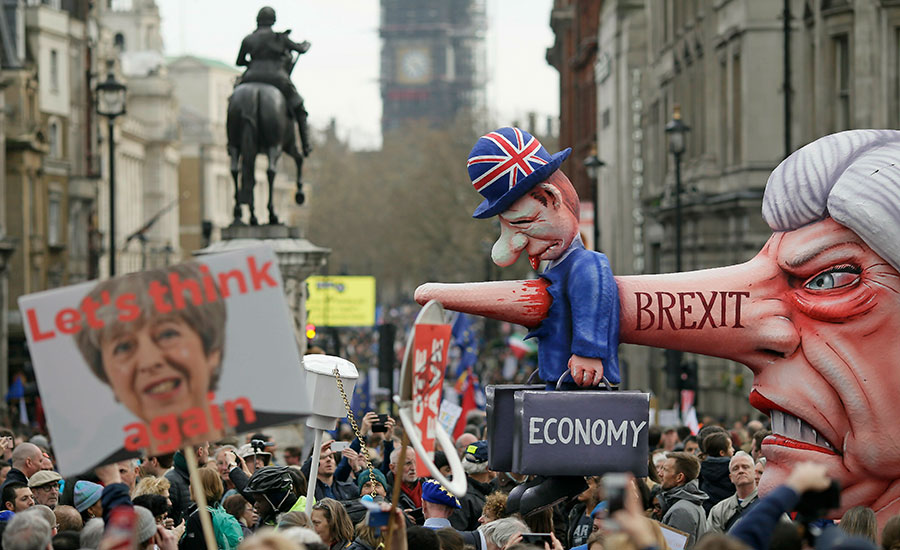One hour before midnight local time this March 29 should have seen the United Kingdom leave the European Union with a divorce settlement sealed and terms of a future relationship ready to be inked in.
Ideally, UK construction and other industries would have had enough time to adjust to a world without free movement of labor and goods with the remaining EU member countries, a benefit that came with 46 years of membership in the trading bloc of 500 million people.
But the profound uncertainty that has characterized the British government’s Brexit tactics for two years will continue because of Prime Minister Theresa May’s inability to get a Brexit deal ratified at home and the Mar. 21 vote by government heads of the remaining 27 EU states to extend the exit deadline.
Departure is now set for May 22, if May secures parliamentary ratification for her draft EU exit treaty. It has already been rejected twice in Parliament by large majorities. If she fails again this week she has until April 12 to come up with another plan or take the UK out of the EU without a treaty—the so-called "no-deal" Brexit that many observers fear.
Forecasts by government, industry associations and most economic think tanks consider the no-deal outcome deeply damaging, although a core of “Brexiteers” in parliament would welcome it. They argue the UK could deal with the EU and international markets under the terms and framework of the Word Trade Organization.
But crashing out of the EU without a deal could lead to a 4% fall in UK construction output this year and 2% in the next, leaders of five major construction trade groups told the Prime Minister in a recent letter. “The immediate effect of leaving without a deal…is not knowing the cost of the materials and goods that construction projects rely on, or if they will arrive on sites.”
In preparing for a possible no-deal, firms have already been “spending valuable time and resources” on stockpiling, logistics contingencies, ensuring security of supply chain and assessing contractual risks and obligations, added the construction leaders. Describing the no-deal option as “a disaster for the UK,” Alan Vallance, CEO of the Royal Institute of British Architects reports projects are already being shelved “as uncertainty damages the investment climate and many EU architects in the UK are still uncertain about their future."
The UK set off on path to the current impasse when May formally gave the EU notice of leaving nine months after the UK voted for Brexit in a referendum in June 2016. Under EU treaties, the UK must leave on Mar. 29 this year unless it secures an extension, requiring approval by all the other member governments. The UK could also unilaterally revoke its notice to quit, and carry on as before. And it could just walk away without a treaty.
Months of negotiations followed, deliberately omitting any formal input from other political parties or industry and trade union groups.
On Nov. 14, 2018, May published a 585-page draft Brexit treaty, which for sometimes arcane reasons, was widely rejected. She set Dec. 11 for the parliamentary vote on the deal that would take place after five days’ debate. After 164 speeches, it was obvious she lacked enough support.
Accused of “running down the clock” by Jeremy Corbyn, leader of the opposition, May stalled the vote for five week until mid-January. Her defeat then by 230 votes was the “largest in parliamentary history” for a government, according to house speaker John Bercow.
Her second attempt in February lost by 149 votes. A final decisive vote is due this week, potentially opening many possibilities, with remaining in the EU a remote possibility.
While May’s tactics have created a febrile political atmosphere in the UK, with lawmakers even receiving death threats, the construction sector has been looking at the longer prospects outside the EU.
Of the possible impacts, the potential introduction of new border controls and tariffs have been the greatest worries for manufacturing, agriculture and other sectors that trade physical goods with what is the UK’s largest single trade market.
For the construction industry, “we are most focused on the labor element,” says Alasdair Reisner, CEO of the Civil Engineering Contractors Association. With up to half the London-area construction workforce and nearly 10% of the national construction workforce drawn from the EU, the end of free movement creates a potential resource crisis.
Equipment manufacturers in both the UK and EU are already readying contingencies.
The free movement of people, goods and capital are mandated by the "Single Market" covering the whole of the EU. Those freedoms would be eliminated by May’s proposed treaty, which would take the UK out of Single Market.
The government’s new draft immigration policy would remove that free movement right from EU citizens and set a $39,500 minimum annual wage as a condition for a work permit. Some lower paid workers would be allowed entry, but for 12 months only. “We don’t expect many people will like that,” adds Reisner.
Workers from Poland and Romania are already “not coming because their home markets are stronger,” says Reisner, and because of Brexit “they don’t feel terribly welcome."
For construction products and materials, Brexit has already been inflationary since the referendum result caused a sharp drop in the value of UK currency. The EU accounts for well over half of imported construction products and materials, totaling $7.5 billion in 2016, according to a report by Balfour Beatty Group plc.
Project owners will face rising costs while supply chain companies are increasingly concerned about inflation on long-date contacts, adds Balfour Beatty.
The company also anticipates lower availability of project financing caused by the UK’s withdrawal from the EU’s European Investment Bank. “Losing access to this funding stream could impact project delivery across the UK … the funding would need to be replaced,” it notes.
The European Investment Bank has provided the UK with over $120 billion of low cost and long-term financing for infrastructure projects. It accounted for around one-third of total investment in UK infrastructure in 2015, according to a parliamentary study.
Not only will the UK likely lose a large slice of this funding, but it will also cease to profit from its $4.6-billion of shareholding in the bank.
Under May’s deal, the EU would repay that capital over 12 years but retain any profits and dividends, which, says the report, could amount to $10 billion.



